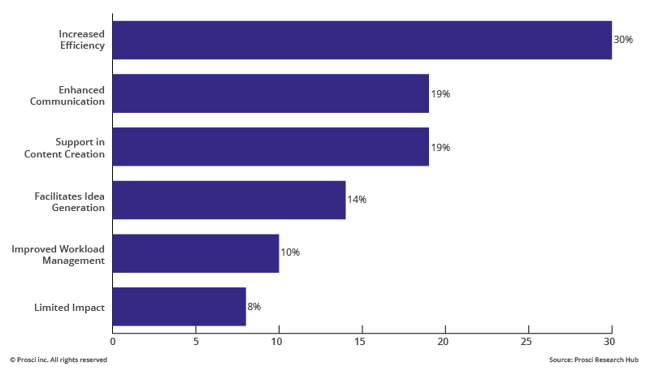5 Steps to Better Change Management Communication + Template

13 Mins
Updated: August 5, 2025
Published: March 31, 2024

Change is constant. In fact, recent findings suggest that 78% of businesses predict more change over the next three years. Although our research shows that frequent and open communication is a top contributor to successful change, ineffective communications have the opposite effect. A lack of effective communication leads to misalignment and confusion, which creates a need for more time and resources during change.
This article draws from Prosci best practices to give you five actionable tips that will enhance your communication and increase your project's chances of success.
Communicating for Change Success
Open, consistent communication is consistently cited as a top contributor to change success in our Best Practices in Change Management research studies. Based on this research and 30 years of success with clients, the tips below can help prepare your team for organizational changes of all kinds.
1. Structure your efforts
Communication isn't new to organizations, and many have departments dedicated to this crucial task. However, when communication occurs in the context of a change, it's not effective to simply tell people facts. To help individual employees successfully navigate a transition, communication must be focused and structured in specific ways.
Answer the "what" and the "why"
One aspect of structuring communication for change management involves intentionally and sequentially releasing messages into the organization. An effective communications plan first answers questions about why the change occurs and what it means to individuals.
Once employees have internalized messages about the need for change, communications shift to focus more on how the change impacts people.

Plan targeted communications across different groups
A second aspect of structure relates to the receivers of communications. Over the course of the project, the target of communications might shift from senior leaders to people managers to front-line employees. Each of these groups receives communications throughout the project, but the amount of focus given to each group may adjust. Without a structured communications plan as part of a bigger change management approach, communications may be conveying the right information to the right groups at the wrong times.
Create a Change Communication Strategy
A well-crafted change communication strategy ensures alignment with the broader change management plan. It identifies key audiences, develops targeted messages, and selects effective channels to address stakeholder concerns. By focusing on clarity and consistency, the strategy fosters understanding and trust, answering crucial questions like "Why is this happening?" and "What's in it for me?"
This integration ensures communications support the change process, guiding employees through each phase while reinforcing the organization's vision and goals.
Create a formal communications plan
From a more tactical perspective, structuring the communication effort means creating a formal communications plan as a tangible deliverable for the project. Communications should not be ad hoc. They should be designed and deliberate. Communicating without planning the communication effort is ineffective.
Effectively planning for communications and then integrating these communications into the overall change management and project plans ensures that information delivery aligns with project progress without missing messages or points in the timeline. To create a structured plan, practitioners need to follow a structured process, like those outlined in our checklist.
Follow these steps for an effective change management communications plan
Although there is no single communication model for change management, the Prosci ADKAR® Model helps make communications more effective. ADKAR represents the five building blocks or elements that a person needs to adopt a change successfully:
- Awareness – Of the need for change
- Desire – To participate and support the change
- Knowledge – On how to change
- Ability – To implement the required skills and behaviors
- Reinforcement – To sustain the change
It also lets you check how well your communication works throughout the change process.
Our ADKAR Model provides a framework for aligning communications and actions to your audience's mindset during each phase.
It’s a flexible model that can be adapted to changes of all kinds. It's helpful for changes that impact one person, 100 people, or 10,000 people. Here's a summary of how to leverage the model when delivering change management communications in organizations:
- Assess – Evaluate the current awareness levels of various employee groups. This establishes a starting point.
- Design – Customize messages and mediums based on the desired ADKAR outcome for each audience segment.
- Deliver – Share consistent messages using channels tailored to each group. Gather feedback to monitor engagement.
- Evaluate – Review the impact of communications and adjust the plan based on the response.
Typically, a change management communications plan focuses on the Awareness and Reinforcement elements of our ADKAR Model. It informs your efforts to target the right groups, craft the right messages for each, identify the frequency and channels to use, and choose the preferred senders.
How Each Plan Primarily Influences the ADKAR Model
 Each plan impacts different elements of the ADKAR Model. The Communications Plan in the Prosci Methodology primarily impacts Awareness and Reinforcement.
Each plan impacts different elements of the ADKAR Model. The Communications Plan in the Prosci Methodology primarily impacts Awareness and Reinforcement.
Effective communication requires more than just flashy formats and excessive frequency. It involves strategic alignment to the stage of change, customization to the needs of each group, and continuous refinement based on feedback.
2. Start sooner
"No one says they learned about a change too early. But many people say they've learned about a change too late."
—Michelle Haggerty, Chief Operating Officer, Prosci
Communications are most effective when they start early in the project lifecycle. Early Initial communications are more proactive and can mitigate the negative consequences of failing to engage employees.
In fact, starting communication efforts earlier in the project was third on the list of what respondents would do differently on the next project in our Best Practices in Change Management research.
Prevent misinformation and rumors
When employees know a change is coming but don't have answers to key questions, they tend to make them up. The answers they come up with on their own are often different from and worse than the truth. Lack of communication early in a project results in misinformation and rumors, which can be devastating to the project. This misinformation can breed resistance, and it creates large barriers for the project team to overcome later in the project lifecycle.
Engaging leaders in open dialogue with employees, even in the early stages, builds trust. Implementing transparent FAQ sections within communications plans is a best practice. These sections enable you to anticipate and address common questions, providing clarity and reducing speculation.
Fostering employee engagement through early, open communication helps demonstrate respect and concern for how change impacts employees.
Be transparent in your approach
Even if you haven't established all the details for the change, you still need to be communicating it to employees. For instance, you can still share information about the need for change and the risk of not changing, even if you don't have a finalized solution.
Communicating that you don't have all the answers and giving employees a date to expect answers is more effective than remaining silent. Proactive, early communications, even when you do not have all the answers, allows you to take control of the information circulating in the organization.
When enterprises embrace early communication as a core strategy, not just a project necessity, they reap benefits beyond successful change management. Employees are more informed, engaged, and empowered to drive positive outcomes.
When the project hits the go-live point, employees have the information they need to become involved in the solution. Conversely, starting communication late creates an uphill battle for the team, who must share the necessary information while dispelling misinformation and rumors.
3. Do it more often
"Don't hesitate to communicate often, just remember to utilize a variety of vehicles to spread your message effectively."
—Michelle Haggerty, Chief Operating Officer, Prosci
When asked what they would do differently regarding communications, participants in our Prosci Best Practices in Change Management benchmarking research said they would communicate more, more often, to more people, and to all levels of their organizations.
Build understanding through repetition
The significance of frequency in communication lies in building understanding. The first time you communicate a message, employees may not hear or internalize what the business is trying to share. In many instances, the receiver of a communication message is concerned with the personal implications the first time they hear about a change. This orientation influences what parts of a message they take away. If a message is only communicated once, employees will never build the understanding intended. Key messages must be repeated. The Prosci Methodology recommends communicating key messages five to seven times to be effective.
Strike a balance to prevent information overload
Be sure to strike a delicate balance between frequency and information overload. Excessive messaging, even if well-intentioned, risks disengagement. Employees become overwhelmed and tune out when inundated with too much information too often.
Strategically plan communication frequency and content—repetition should reinforce core messages rather than overload people with extra details. The goal is to drive retention of critical points, not attempt to convey every minute aspect.
Use different modes of communication
Communication around change is a process, not an event. It is not a single email, kickoff meeting, or video message broadcasted by the CEO on the intranet.
The “how” of communication involves utilizing multiple mediums, such as newsletters, webinars and team meetings, to consistently repeat and reinforce key messages throughout the project lifecycle. If you're managing change, it's your job to ensure that the team communicates the right details to the right people, not just once but several times.
The post-pandemic era is witnessing a greater shift towards creating opportunities for open dialogue, Q&A sessions, and status-update webinars to address employee concerns.
Organizations employ various communication channels, such as company intranet hubs, electronic bulletin boards, emails, and webinars. Platforms like Slack, Microsoft Teams, and internal social networks facilitate continuous messaging and updates.
A Prosci study shows that AI can significantly impact your enterprise communications.
Impact of AI on Change Management Work
Communications plans must consider the audience's diverse needs, including different roles within the organization.
Establish a feedback loop
Effective communication involves more than repetition—it requires a feedback loop. Feedback means gathering your team's thoughts and feelings about the changes. You can then use their input to improve how you explain the changes and train them, making it easier for everyone to get on board with the new way of doing things.
4. Answer the questions people have
"Employees want to know their concerns and worries have been taken into account and there are strategies in place to navigate the change in a way that considers their needs."
—Michelle Haggerty, Chief Operating Officer, Prosci
Effective communication goes beyond sharing a message—it's an interactive and iterative process to build understanding.
In a well-structured plan, communication efforts should proactively address employees' questions in the order they want to hear the messages.
Address the personal change questions employees might have
One major trap you should anticipate is for a communicator to talk only about what they care about and what they're concerned about.

Senior leaders fall into this trap by communicating exclusively about the vision and future of the organization.
Project team members fall into this trap by communicating solely about the solution they have arrived at and the alternatives they evaluated.
This is not a fault. We want senior leaders to be concerned about the vision of the organization, and we want project team members to be concerned about their solution.
However, when it comes to communicating to employees, efforts should aim to answer the most pertinent questions the employees have about the change.
Several key questions need to be answered at the beginning of a change:
- Why are we changing?
- What are the risks of not changing?
- What's in it for me?
- How will I be impacted?
- How will my team be impacted?
Note that the question, "What are the specific details of the change?" does not appear on the list. Communications plans must first address the questions at the forefront of what people care about before they move into the specific details of the change.
Customize messages for every audience group
Recognize that different stakeholders have distinct concerns and priorities. Tailor your messages to resonate with each group. For example:
With senior managers: Emphasize how the change aligns with strategic goals and the overall vision.
With project team members: Highlight the solution's benefits and how it aligns with project goals.
With front-line employees: Focus on the personal impact, emphasizing benefits to their roles and the support available to them.
By shaping your messages to fit each group's needs, you make sure everyone understands and supports the change, which helps your project succeed faster.
Encourage open dialogue via several platforms
Make space for two-way communication, not just one-sided broadcasting. Create opportunities for open dialogue through town halls, feedback surveys, online forums, and live Q&A sessions. 
Diverse platforms encourage questions, input, and suggestions from employees at all levels. This fosters a culture of transparency where people feel heard, valued, and invested in shaping the change. Large-scale interactive forums play a key role in addressing the wide variety of concerns across the organization.
"As an organizational development professional, I often use Gallup's research to guide sponsors in preparing remarks. Gallup identifies four key needs followers have from their leaders: trust, compassion, stability and hope. In managing change, I help sponsors instill trust through openness and vulnerability, show compassion by empathizing with impacted employees—saying, 'Hey, you know, I've been in your shoes when we did an ERP implementation, and I was the financial analyst. I understand this is a rocky road.' They can tell a story to make a connection and show that. Ensure stability by conveying capable leadership and communicating hope for a positive future. Inspire the group to not get mired down in the struggles of the present but to also look ahead. It helps having a leader who shows the road ahead and how this change initiative is going to ultimately make the lives of the employees and the health of the company better. Trust, compassion, stability and hope. This intentional sponsor plan is a crucial part of our change management methodology."
—Margaret Smith, Principal Change Advisor
5. Use preferred senders
Consider employee communication preferences for how they receive information during times of change. Our Prosci Best Practices in Change Management benchmarking research consistently shows who the preferred senders are and the types of messages they should communicate.
Preferred Senders of Messages

Deliver business-level messages by organization leaders
For business messages about the change, employees want to hear from someone at the top of the organization or their division. These business-level messages include why the change is happening, the risks of not changing, the customer or competitor issues causing the change, why the change is happening right now, how the economic climate played a role in the change, and the alignment of this change with the organization's vision and direction. When it comes to business messages, executives and senior leaders should be the voice for change. Employees want to hear from someone at the top about these issues.
Deliver personal-change messages by supervisors
For personal change messages, employees want to hear from their immediate supervisor. Questions best answered by such people managers include:
- What does this change mean to me?
- What's in it for me? How will my team be impacted?
- How will my day-to-day work be impacted?
This presents somewhat of a challenge because we must get managers and supervisors on board before they can become effective communicators to others.
The "voice" of change matters. Even if a message's content is exactly the same, employees will evaluate the sender. Using preferred senders ensures that messages are received as intended and that the change is taken seriously.
Optimize change management communications with Kaiya
As you navigate the complexities of change management communication, leverage Kaiya™ , Prosci’s expert change management AI tool, to streamline your efforts. Kaiya offers personalized insights and recommendations based on Prosci best practices, ensuring your messages resonate with your audience and drive successful change initiatives.
Change Communications Resources
Effective change communication requires the right tools and resources. Here are some essential aids that can enhance your change management efforts.
Communications plan template for change management
Our Communications Checklist for Change Management is your template for aligning your communications strategy with best practices. Here are just some of the tips it offers:
Use preferred senders
Employees trust certain voices for specific messages. Senior leaders should communicate the "big picture" of why the change is happening and its alignment with organizational goals. Immediate supervisors are best for personal impact messages, answering questions like “How will this affect my role?” and “What’s in it for me?” (WIIFM).
Prepare and equip your senders
Successful communication requires intentional preparation. Equip your leaders and managers with clear, pre-drafted messages, consistent talking points, and training on how to address concerns effectively. Sequence and schedule communications to ensure timely delivery without overwhelming the audience.
Answer key questions first
Communication should begin with the foundational “Why?” questions: Why is this happening? Why now? What’s at risk if we don’t change? Once these are addressed, move to the personal “WIIFM” to engage individuals emotionally and practically.
Repeat key messages
Repetition is vital. The Prosci Methodology recommends communicating key messages five to seven times to be effective. Use multiple channels—emails, meetings, forums and digital tools—to reinforce your points without redundancy.
Encourage two-way communication
Create opportunities for feedback through Q&A sessions, forums or surveys. Two-way interactions build trust, address misconceptions, and help employees feel heard and valued.
Evaluate and adapt
Measure the effectiveness of your communication through surveys, focus groups, and feedback loops. Use insights to refine your strategy and ensure your messages are resonating as intended.
This checklist complements tools like our ADKAR Model by helping you align communication efforts with key stages—building Awareness and Reinforcement while tailoring messages to meet audience needs.

How not to use your communications plan
A communications plan is an important tool, but it’s not a complete change management solution on its own. Without integrating it into a broader strategy, even the most well-crafted communications plan can fall short. To truly drive success, communication must complement other activities like sponsorship and coaching.
One common pitfall is using the plan as a standalone effort rather than aligning it with the overall change initiative. Communications should reinforce key change management actions, like addressing employee concerns or preparing managers to guide their teams.
For example, simply broadcasting updates isn’t enough. Instead, you should focus on the key questions your team members are asking. Tailored messaging is vital, as different stakeholders—executives, managers and employees—require unique information.
Additionally, overloading employees with generic details or misaligned messages can create confusion or resistance. Instead, timing and sequencing are critical. Communications should flow in a way that reflects the project’s progression, ensuring employees are prepared for what’s next. Remember, a plan is only as effective as its implementation.
Why some communications work and others don’t
Effective change communication hinges on understanding the sender-receiver dynamic. Often, what a sender conveys and what a receiver interprets differ significantly. For instance, a manager might discuss organizational restructuring positively, but employees may perceive job insecurity. This underscores why using preferred senders for personalized messages is key to why some communications work better than others.
Aligning with the emphasis on using preferred senders, it's crucial to recognize that employees prefer to receive messages from specific sources. To do this well, divide your communications into two categories:
- Organizational messages: Employees want to hear from senior leaders about the reasons for change and its alignment with company goals.
- Personal impact messages: Employees prefer direct supervisors to communicate how changes will affect their roles and daily tasks.
This alignment ensures that messages are both credible and relevant, fostering trust and clarity.
Don’t forget about the need for repetition and varied communication methods, either. Delivering key messages multiple times through diverse channels—such as meetings, emails and informal discussions—reinforces understanding and retention. This multichannel approach caters to different learning styles and helps reduce misunderstandings.
Change Management Communication Is Evolving
Communication strategies are adapting to the digital age and remote work environments. The landscape of preferred senders may continue to shift to reflect remote or hybrid models.
A dynamic leader who actively steers the organization through change and remains visibly engaged throughout the change journey continues to be the key to success. An impactful Communications Plan empowers them to showcase their trustworthiness, empathy, authenticity, self-awareness and commitment to continuous learning.
The 12th Edition of Prosci’s Best Practices in Change Management research report is a great resource for understanding how change management has evolved and how to lead through change effectively.
Frequently Asked Questions
What type of communication is needed for Change Management?
Through change management communications, stakeholders are educated, guided and supported during organizational change. One can do this by sending out consistent emails, conducting coaching and training sessions, and having in-person meetings.
A Communications Plan is one of the core change management plans recommended in the Prosci Methodology. An effective change management communications plan targets each stakeholder group impacted by the change and focuses on what they care about and need to know. A structured communications plan presents the right messages at the right time, in the right format, via the right channel, and from the right sender.
What are the communication objectives of Change Management?
Effective change management communications ensure that everyone is well-informed about the upcoming changes. It’s important to tailor these communications to each specific audience, address their concerns, and provide a clear understanding of why the change is happening. By strategically timing the messages and considering the content and sender, we can successfully navigate the change process and foster a smooth transition.
What’s the difference between Change Management and Change Communication?
Change management is a structured approach to implementing successful organizational programs and initiatives. It involves creating detailed plans for big company changes—including getting everyone ready and aligned. Change communication is how we tell everyone about the plan and keep them informed.
Quality change management integrates strategic communication, ensuring the right information is delivered to the right people at the right time. But it’s important to note that while clear communication is crucial, it's just one aspect of executing change successfully.
A comprehensive organizational change management approach includes other plans, as well as assessments, a structured process, models and tools, and more. This Change Management Checklist helps see if you’re taking a proactive, systematic, and thorough approach when managing change.
Change Management Communication
for Better Results
An effective communication strategy is vital to change management success. As discussed, strategies like structured plans, early messaging, repetition, answering questions, and preferred senders help employees understand and accept changes faster.
Communicating during change is not a single event that ends when you press "send." An intentional, structured plan with focused messages sent from the right people at the right time helps impacted employees understand and accept the changes faster while heading off problems—all while setting up your project and people for success. An intentional plan with focused messages from the right people at the right times sets up your project and people for success.




